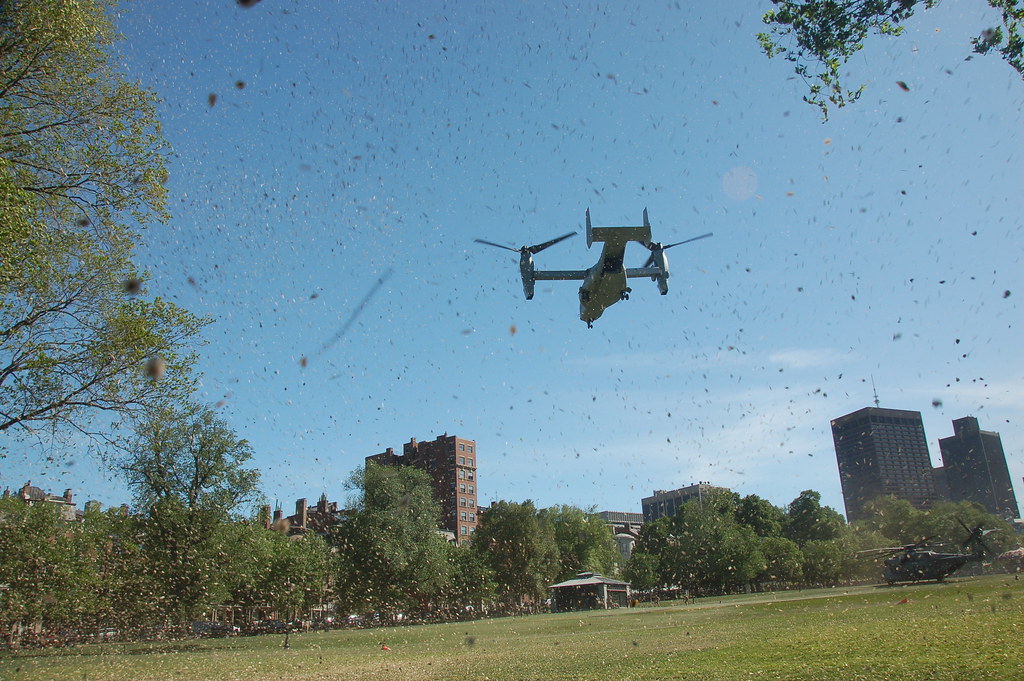
U.S. Marine Corps parachutists free fall from an MV-22 Osprey at 10,000 feet above the drop zone at Fort A.P. Hill, Va. on Jan. 17, 2000. The Marines from the 2nd Reconnaissance Battalion, 2nd Marine Expeditionary Force, Camp Lejeune, N.C., became the first to deploy from the Osprey. Twenty-four successful jumps were recorded under the supervision of the U.S. Army Operational Test Command and the Marine Corps Systems Command to qualify the V-22 for parachute service. DoD photo by Vernon Pugh, U.S. Navy. (Released)
June 6, 2019, a day marked by both solemn remembrance and a demonstration of military strength, saw the U.S. Marine Corps exhibit its impressive aerial capabilities in a striking display of combat readiness.

At the heart of the exercise was the awe-inspiring “Elephant Walk,” featuring the advanced MV-22 Osprey aircraft at Marine Corps Air Station Miramar, paying homage to the 75th anniversary of D-Day.

The Elephant Walk, a term coined from World War II when bombers would taxi in a procession reminiscent of the giant land mammals, has evolved from a strategy to a powerful exhibition of airpower.

While historically linked to bombers and fighter jets, the 2019 iteration presented a novel spectacle, with tiltrotor technology taking center stage.

In a meticulously choreographed sequence, 26 MV-22B Ospreys joined 14 CH-53E Super Stallions in a combat readiness exercise spanning over Southern California.

GULF OF AQABA (Oct. 4, 2007) – U.S. Marine Corps MV-22 Ospreys, assigned to Marine Medium Tiltrotor Squadron (VMM) 263, Marine Aircraft Group 29, prepare for flight on the deck of the multipurpose amphibious assault ship USS Wasp (LHD 1). Wasp is on surge deployment to the Middle East carrying the Osprey to its first combat deployment. U.S. Navy photo by Chief Mass Communication Specialist Craig Strawser (RELEASED)
The event was not just a show of force but also an operational drill with the majority of aircraft engaging in tactical training post-launch.

Col. Craig C. Leflore, commanding officer of MAG-16, expressed the significance of the event with clear intent: “MAG-16 has executed our maximum flight event to demonstrate the combat readiness of our MAG and to tell the MAG-16 story. We want to test ourselves. If there is a crisis somewhere in the world, our job is to be ready to respond to that crisis at a moment’s notice.”

The MV-22 Osprey, procured in 1999, represents a revolutionary blend of helicopter and fixed-wing aircraft technologies.

Capable of vertical takeoffs and landings, it transitions to high-speed, long-range flight by tilting its rotors.

Its unique flight capabilities, including carrying over 6,000lb of cargo across 400 nautical miles at a cruise speed of 266 knots, underscore the advanced technological edge held by the U.S. Marine Corps.

A stark reminder of this technological prowess was highlighted during the Elephant Walk.

Where the sight of the Ospreys in formation underscored an unspoken message to global adversaries – the United States military holds an unparalleled technological advantage with the tiltrotor aircraft.

The Ospreys, alongside the Super Stallions, form the backbone of MAG-16.

They play an integral role in executing the Marine Air-Ground Task Force’s diverse missions, from combat operations to humanitarian aid.

ATLANTIC OCEAN (Feb. 20, 2008) A Marine Corps MV-22 Osprey prepares to land aboard the amphibious assault ship USS Nassau (LHA 4). The Nassau Strike Group is en route to the NavyÕs 5th and 6th Fleet areas of responsibility in support of maritime security operations. U.S. Navy photo by Lt. j.g. Anthony Falvo (Released)
MAG-16 regularly operates these aircraft, honing the skills necessary to respond efficiently to any situation.
Relevant articles:
– 20 MV-22 Osprey Did an ‘Elephant Walk’ and It Was Glorious, The National Interest
– 22 Osprey, marines.mil
– Airforce Technology, airforce-technology.com
– Twenty six MV-22B Ospreys and 15 CH-53E Super Stallions Stage Impressive “Elephant Walk” At MCAS Miramar, The Aviationist, Jun 12, 2019

